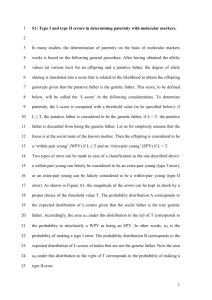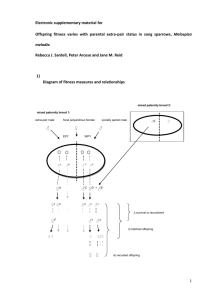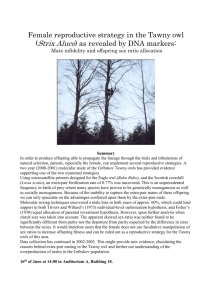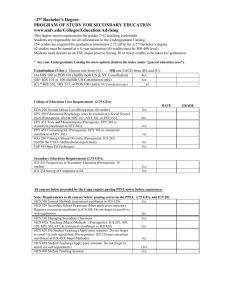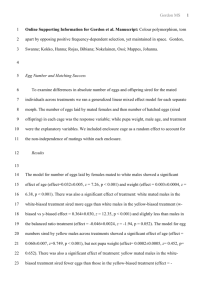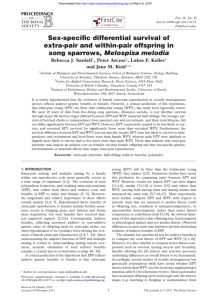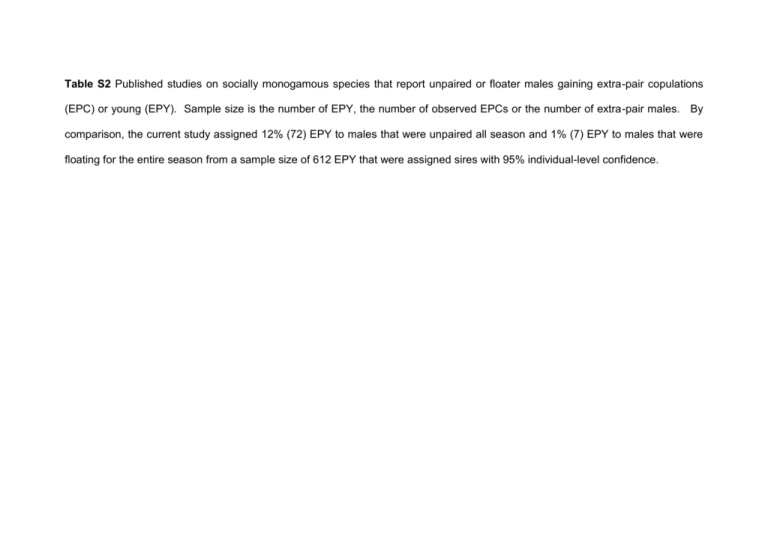
Table S2 Published studies on socially monogamous species that report unpaired or floater males gaining extra-pair copulations
(EPC) or young (EPY). Sample size is the number of EPY, the number of observed EPCs or the number of extra-pair males. By
comparison, the current study assigned 12% (72) EPY to males that were unpaired all season and 1% (7) EPY to males that were
floating for the entire season from a sample size of 612 EPY that were assigned sires with 95% individual-level confidence.
Reference
Species
Male status
Paternity
Sample size
Albrecht et al. 2007
Scarlet rosefinch
Unpaired
1 unpaired male sired 3 EPY
48 EPY
Floater
5 EPCs by floaters observed
17 EPCs
Unpaired
17% (6) EPY sired by unpaired males
36 EPY
Floater
EPCs by non-resident floaters observed
-
Floater
34% EPY (30) assigned floater male as
89 EPY
Carpodacus erythrinus
Barber & Robertson
1999
Bollinger & Gavin 1991
Tree swallow
Tachycineta bicolor
Bobolink
Dolichonyx oryzivorus
Brown & Brown 2004
Cliff swallow
Petrochelidon pyrrhonota
Castro et al. 2004
Stitchbird
Notiomystis cincta
sire
Churchill & Hannon
2010
Currie et al. 1998
American redstart
Floater
~50% (6) males cuckolded by floaters
13 males
Unpaired
1 EPY sired by an unpaired male
8 EPY
Floater
3 males engaging in EPCs were floaters
34 extra-pair
Setophaga ruticilla
Northern wheatear
Oenanthe oenanthe
Dickinson 2001
Western bluebird
males
Sialia mexicana
Dunn & Whittingham
2007
Ewen et al. 1999
Tree swallow
Floater
Floater
Dusky warbler
45% (5) EPY assigned floater male as
11 EPY
sire
Notiomystis cincta
Forstmeier et al. 2002
102 EPY
sire
Tachycineta bicolor
Stitchbird
15% (15) EPY assigned floater male as
Unpaired
EPY sired by unpaired males, exact
88 EPY
Phylloscopus fuscatus
Freeman-Gallant et al.
2009
Hamao & Saito 2005
Common yellowthroat
number not stated
Unpaired
1 EPY sired by an unpaired male
48 EPY
Floater
22% (2) EPY sired by floaters
9 EPY
Unpaired
3 sires were unpaired
14 EPY
Floater
20% EPY (7) sired by floaters
35 EPY
Unpaired
Chicks in 2 EPP nests sired by 2
19 EPY
Geothlypis trichas
Black-browed reed warbler
Acrocephalus bistrigiceps
Kappes et al. 2009
American redstart
Setophaga ruticilla
Kempenaers et al. 2001
Tree swallow
Tachycineta bicolor
Leisler et al. 2000
Great reed warbler
Acrocephalus
unpaired males
arundinaceus
Martin & Hannon 1988
Willow ptarmigan
Lagopus lagopus
Floater /
One successful and 3 unsuccessful EPC
14 EPC
Unpaired
attempts by floater males. One
attempts
unsuccessful EPC attempted by an
unpaired male.
Pearson et al. 2006
Petren et al. 1999
Willow flycatcher
Floater
31% EPY (5) sired by floaters
Empidonax traillii
Unpaired
6% EPY (1) sired by unpaired male
Cactus finch
Unpaired
5 extra-pair sires were unpaired males
Indigo bunting
Passerina cyanea
9 extra-pair
sires (12 EPY)
Geospiza scandens
Westneat 1987
16 EPY
Unpaired
3 males assigned as extra-pair sires
18 extra-pair
were unpaired
sires
References
Albrecht T, Schnitzer J, Kreisinger J, Exnerova A, Bryja J, Munclinger P (2007) Extrapair paternity and the opportunity for sexual
selection in long-distant migratory passerines. Behavioral Ecology, 18, 477-486.
Barber CA, Robertson RJ (1999) Floater males engage in extrapair copulations with resident female tree swallows. Auk, 116, 264269.
Bollinger EK, Gavin TA (1991) Patterns of Extra-Pair Fertilizations in Bobolinks. Behavioral Ecology and Sociobiology, 29, 1-7.
Brown CR, Brown MB (2004) Mark-recapture and behavioral ecology: a case study of Cliff Swallows. Animal Biodiversity and
Conservation, 27, 23-34.
Castro I, Mason KM, Armstrong DP, Lambert DM (2004) Effect of extra-pair paternity on effective population size in a reintroduced
population of the endangered hihi, and potential for behavioural management. Conservation Genetics, 5, 381-393.
Churchill JL, Hannon SJ (2010) Off-territory movement of male American Redstarts (Setophaga ruticilla) in a fragmented
agricultural landscape is related to song rate, mating status and access to females. Journal of Ornithology, 151, 33-44.
Currie DR, Burke T, Whitney RL, Thompson DBA (1998) Male and female behaviour and extra-pair paternity in the wheatear.
Animal Behaviour, 55, 689-703.
Dickinson JL (2001) Extrapair copulations in western bluebirds (Sialia mexicana): female receptivity favors older males. Behavioral
Ecology and Sociobiology, 50, 423-429.
Dunn PO, Whittingham LA (2007) Search costs influence the spatial distribution, but not the level, of extra-pair mating in tree
swallows. Behavioral Ecology and Sociobiology, 61, 449-454.
Ewen JG, Armstrong DP, Lambert DM (1999) Floater males gain reproductive success through extrapair fertilizations in the
stitchbird. Animal Behaviour, 58, 321-328.
Forstmeier W (2002) Factors contributing to male mating success in the polygynous dusky warbler (Phylloscopus fuscatus).
Behaviour, 139, 1361-1381.
Freeman-Gallant CR, Taff CC, Morin DF, Dunn PO, Whittingham LA, Tsang SM (2010) Sexual Selection, Multiple Male Ornaments,
and Age- and Condition-Dependent Signaling in the Common Yellowthroat. Evolution, 64, 1007-1017.
Hamao S, Saito DS (2005) Extrapair fertilization in the black-browed reed warbler (Acrocephalus bistrigiceps): Effects on mating
status and nesting cycle of cuckolded and cuckolder males. Auk, 122, 1086-1096.
Kappes PJ, Stutchbury BJM, Woolfenden BE (2009) The Relationship between Carotenoid-Based Coloration and Pairing, Withinand Extra-Pair Mating Success in the American Redstart. Condor, 111, 684-693.
Kempenaers B, Everding S, Bishop C, Boag P, Robertson RJ (2001) Extra-pair paternity and the reproductive role of male floaters
in the tree swallow (Tachycineta bicolor). Behavioral Ecology and Sociobiology, 49, 251-259.
Leisler B, Beier J, Staudter H, Wink M (2000) Variation in extra-pair paternity in the polygynous Great Reed Warbler (Acrocephalus
arundinaceus). Journal Fur Ornithologie, 141, 77-84.
Martin K, Hannon SJ (1988) Early Pair and Extra-Pair Copulations in Willow Ptarmigan. Condor, 90, 245-246.
Pearson T, Whitfield MJ, Theimer TC, Keim P (2006) Polygyny and extra-pair paternity in a population of Southwestern Willow
Flycatchers. Condor, 108, 571-578.
Petren K, Grant BR, Grant PR (1999) Low extrapair paternity in the cactus finch (Geospiza scandens). Auk, 116, 252-256.
Westneat DF (1987) Extra-pair fertilizations in a predominantly monogamous bird: genetic evidence. Animal Behaviour, 35, 877886.


